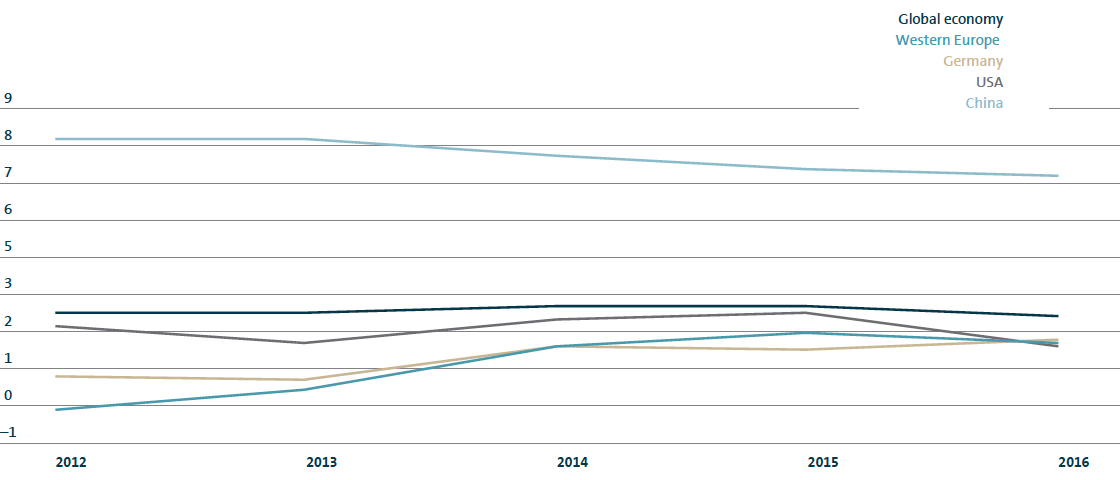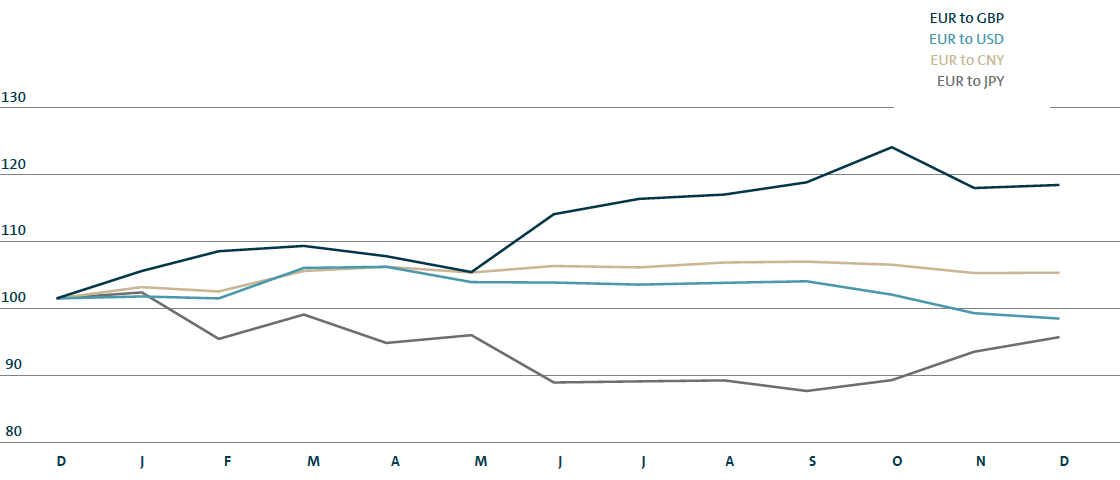Business Development
The pace of global economic growth was slightly slower in 2016 than in the previous year. By contrast, global demand for vehicles was higher. Despite a persistently difficult environment, the Volkswagen Group delivered more than 10 million vehicles to customers.
GLOBAL ECONOMY GROWS MODERATELY
The moderate growth rate of the global economy slowed to 2.5 (2.8)% in fiscal year 2016. While economic momentum decelerated in the industrialized countries as a whole, growth rates in emerging economies remained virtually constant year-on-year. Inflation increased as a result of the expansionary monetary policies pursued by many central banks and due to rising energy and commodity prices.
Europe/Other Markets
The economy of Western Europe continued to recover in the reporting period. At 1.7 (2.0)%, growth in gross domestic product (GDP) was slightly lower than in the previous year. The picture was mixed as regards economic growth in both Northern and Southern Europe. The UK’s Brexit referendum in June, when a small majority voted to leave the EU, had a dramatic effect, with direct consequences including uncertainty in the financial markets and dimmer economic prospects for the United Kingdom and Europe as a whole. The eurozone unemployment rate continued to decrease, falling to an average of 10.6 (11.3)%, though rates remained considerably higher in Greece and Spain.
Although GDP grew by a total of 1.3 (0.8)% in Central and Eastern Europe in the reporting period, it remained at a relatively low level. Whereas the comparatively high rate of growth in Central Europe weakened considerably compared with the previous year, the recessionary period of the previous year in Eastern Europe came to an end. The recovery in energy prices was the main positive factor in this trend, while the unresolved conflict between Russia and Ukraine continued to have a negative impact. The decline in economic output in Russia by 0.6 (−3.7)% was much less pronounced in the reporting period than in 2015.
South Africa’s GDP expanded by just 0.4 (1.3)%, thus falling substantially short of the already low figure of the previous year. In addition to a severe drought, ongoing structural deficits and social unrest weighed on the economy.
Germany
The German economy continued to profit from positive consumer sentiment and a good labor market, with the 1.8 (1.5)% rise in GDP being somewhat stronger than in the previous year.
North America
At 1.6 (2.6)%, economic growth in the USA was slightly lower year-on-year. The economy was supported primarily by private consumption and expansionary monetary policy, whereas private investment growth was weak. The average unemployment rate during the reporting period was 4.9 (5.3)%. The US dollar remained strong, putting domestic goods exports under pressure. At 1.3 (0.9)%, GDP growth in Canada showed only little momentum. Mexico’s economic output fell to 2.1 (2.6)%.
South America
Brazil experienced its second consecutive year of recession, with economic output falling by 3.6 (−3.8)%. Weak domestic demand, continuing relatively low global commodity prices and political uncertainty weighed on the economy. Argentina’s GDP declined by 2.3 (+2.6)%, with structural deficits and high inflation continuing to hamper growth.
Asia-Pacific
Economic growth in China weakened slightly in 2016, mainly due to structural changes. At 6.7 (6.9)%, however, it was still high compared with other countries worldwide. The Indian economy continued its positive trend with a gain of 6.8 (7.5)% and thereby grew somewhat more slowly than in the previous year. Japan once again posted weak GDP growth of just 1.0 (1.2)%.

